Pathogen antigen epitopes Studienführer, Klassennotizen & Zusammenfassungen
Suchst du nach den besten Studienführern, Studiennotizen und Zusammenfassungen über Pathogen antigen epitopes? Auf dieser Seite findest du 119 Studienunterlagen zu Pathogen antigen epitopes.
All 119 Ergebnisse
Sortieren nach
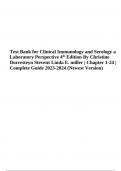
-
Test Bank for Clinical Immunology and Serology a Laboratory Perspective 4th Edition By Christine Dorresteyn Stevens Linda E. miller Chapter 1-24 Latest Guide 2023-2024
- Prüfung • 159 Seiten • 2023
-
- $29.49
- 1x verkauft
- + erfahre mehr
Test Bank for Clinical Immunology and Serology a Laboratory Perspective 4th Edition By Christine Dorresteyn Stevens Linda E. miller Chapter 1-24 Latest Guide 2023-2024. Which of the following is a characteristic of natural killer cells? A. They mature in the thymus. B. They are smaller than B and T cells. C. They are a type of lymphocyte. D. They are part of the adaptive immune system. ANS: C 5. Which of the following best describes diapedesis? A. Movement toward increasing concentrations...
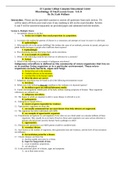
-
Microbiology 33 Final Lecture Exam A & B (GRADED A) Questions and Answers
- Prüfung • 31 Seiten • 2022
-
- $10.99
- 1x verkauft
- + erfahre mehr
El Camino College Compton Educational Center Microbiology 33 Final Lecture Exam A & B By Dr. Eyob Wallano Instruction: Please use the provided scantron to answer all questions from each section. 5% will be taken off from your total score if any marking is left on the exam booklet. Section E and F will be answered separately on provided paper and submitted with the booklet. Section A. Multiple Choice 1. An epidemic disease is one that A. breaks out in higher than usual proportions in a p...
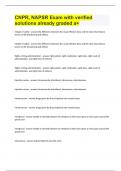
-
CNPR, NAPSR Exam with verified solutions already graded a+
- Prüfung • 97 Seiten • 2024
-
Im Paket-Deal erhältlich
-
- $15.49
- + erfahre mehr
Drug Discovery • Unlike small molecule drugs (pharmaceuticals), large molecule drugs (biopharmaceuticals) are mainly protein-based o These protein-based drugs are similar to natural biological compounds found in human body or they're fragments that mimic active part of natural compounds Discovery of Pharmaceuticals commences w/ scanning hundreds of compounds, whether w/ actual materials (irrational approach) or virtual simulations (rational approach) • Pharmaceuticals are new che...
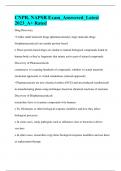
-
CNPR, NAPSR Exam_Answered_Latest 2023+ Rated|CNPR, NAPSR Exam Guide (Complete with A+ Rated Answers)
- Prüfung • 112 Seiten • 2023
-
Im Paket-Deal erhältlich
-
- $15.49
- + erfahre mehr
CNPR, NAPSR Exam_Answered_Latest 2023+ Rated Drug Discovery • Unlike small molecule drugs (pharmaceuticals), large molecule drugs (biopharmaceuticals) are mainly protein-based o These protein-based drugs are similar to natural biological compounds found in human body or they're fragments that mimic active part of natural compounds Discovery of Pharmaceuticals commences w/ scanning hundreds of compounds, whether w/ actual materials (irrational approach) or virtual simulations (ratio...
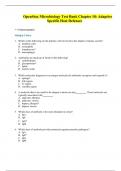
-
OpenStax Microbiology Test Bank Chapter 18: Adaptive Specific Host Defenses
- Prüfung • 13 Seiten • 2024
- Im Paket-Deal erhältlich
-
- $17.00
- + erfahre mehr
OpenStax Microbiology Test Bank Chapter 18: Adaptive Specific Host Defenses * = Correct answer Multiple Choice 1. Which of the following are the primary cells involved in the adaptive immune system? A. dendritic cells B. eosinophils C. lymphocytes* D. macrophages 2. Antibodies are made up of which of the following? A. carbohydrates B. glycoproteins* C. lipids D. nucleic acids 3. Which molecular fragment on an antigen molecule do antibodies recognize and respond to? A. ep...
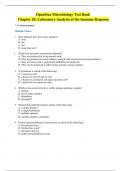
-
OpenStax Microbiology Test Bank Chapter 20: Laboratory Analysis of the Immune Response
- Prüfung • 13 Seiten • 2024
- Im Paket-Deal erhältlich
-
- $14.00
- + erfahre mehr
OpenStax Microbiology Test Bank Chapter 20: Laboratory Analysis of the Immune Response * = Correct answer Multiple Choice 1. Most antigens have how many epitopes? A. none B. one C. two D. more than two* 2. Which best describes monoclonal antibodies? A. They are produced in living animals only. B. They are produced in tissue cultures, using B cells extracted from living animals.* C. They are rarely used, so polyclonal antibodies are preferred. D. They can be produced in either liv...
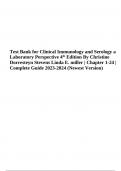
-
Test Bank for Clinical Immunology and Serology a Laboratory Perspective 4th Edition By Christine Dorresteyn Stevens Linda E. miller | Chapter 1-24 | Complete Guide 2023-2024 (Newest Version)
- Prüfung • 159 Seiten • 2023
-
- $32.49
- + erfahre mehr
Test Bank for Clinical Immunology and Serology a Laboratory Perspective 4th Edition By Christine Dorresteyn Stevens Linda E. miller | Chapter 1-24 | Complete Guide 2023-2024 (Newest Version). Eosinophils are involved in the immune response against: A. viruses. B. intracellular bacteria. C. parasites that cannot be phagocytized. D. extracellular bacteria. ANS: C 2. Which of the following are components of both innate and adaptive immune responses? A. Immunoglobulins B. T helper cells C. ...
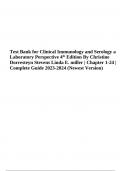
-
Test Bank for Clinical Immunology and Serology a Laboratory Perspective 4th Edition By Christine Dorresteyn Stevens Linda E. miller | Chapter 1-24 Newest Version 2023-2024
- Prüfung • 159 Seiten • 2023
-
- $34.49
- + erfahre mehr
Test Bank for Clinical Immunology and Serology a Laboratory Perspective 4th Edition By Christine Dorresteyn Stevens Linda E. miller | Chapter 1-24 Newest Version 2023-2024. Which of the following are components of both innate and adaptive immune responses? A. Immunoglobulins B. T helper cells C. Macrophages D. B cells ANS: C 3. The process by which leukocytes are attracted to a specific area by chemical messengers is called: A. diapedesis. B. degranulation. C. chemotaxis. D. opsonizati...
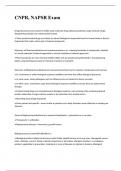
-
CNPR, NAPSR Exam 2023 questions with correct answers
- Prüfung • 71 Seiten • 2023
-
- $12.99
- + erfahre mehr
Drug Discovery • Unlike small molecule drugs (pharmaceuticals), large molecule drugs (biopharmaceuticals) are mainly protein-based o These protein-based drugs are similar to natural biological compounds found in human body or they're fragments that mimic active part of natural compounds Discovery of Pharmaceuticals commences w/ scanning hundreds of compounds, whether w/ actual materials (irrational approach) or virtual simulations (rational approach) • Pharmaceuticals are new che...
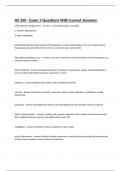
-
HS 350 - Exam 3 Questions With Correct Answers
- Prüfung • 29 Seiten • 2023
-
- $12.99
- + erfahre mehr
Cells adapt by changing their: - Answer 1. size (hypertrophy or atrophy) 2. number (hyperplasia) 3. type (metaplasia) Relationship between hypertrophy and hyperplasia - Answer Hypertrophy occurs in cell types where hyperplasia, the generation of more cells, is uncommon (eg. muscle cells) Why might metaplasia occur? - Answer it occurs in response to chronic irritation and inflammation; one cell type replaces another Define dysplasia - Answer deranged cell growth resulting in varying si...

Studienstress? Für Verkäufer auf Stuvia sind das eigentlich goldene Zeiten. KA-CHING! Verdiene auch mit deinen Zusammenfassungen und fange jetzt an, sie hochzuladen. Entdecke alles über Verdienstmöglichkeiten auf Stuvia


